The sewer backflow preventers are one of the most important parts of a sewage system. These are also known as backwater sanitary valves. They are responsible for keeping the wastewater from getting back into homes from public sewers.
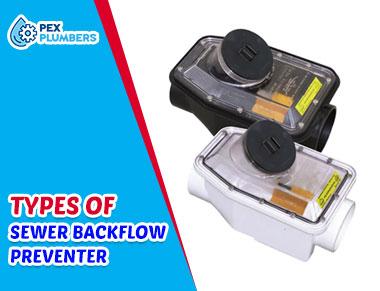
Moreover, the usual flow of wastewater is from home to city water.
So going from city sewer to homes is considered the backflow. And that is where sewer backflow preventers work.
There are a few different types of backflow preventers.
How and where they are used depends on the context. But first, let us understand the circumstances where a backflow occurs.
What Causes Sewer Backflow?
The sanitary sewers put in place work with the natural force of gravity. It means the wastewater flows in the direction of the pipe’s slope.
Backflows happen when a few different triggers are present. They are as follows:
- Blockages
- Overflow due to heavy rain or melted snow
- Back-pitched drain system
- When it becomes inadequate for handling large infrastructures
- Leaked pipes
Blockages and overflowing of the pipes are the two main causes of backflow. There are multiple factors behind blockages, such as the accumulation of grease, hair, and things like that. And during heavy rain, when it floods, the sewage system cannot handle the pressure.
When the wastewater doesn’t have anywhere to go, it finds its way back to our homes.
Hazards Connected to Backflow
The hazards occurring after a backflow are multifaceted. We can guess what kind of hazards we’ll be facing if wastewater flows back toward the homes.
The first one to get hit will be the health of our families and neighbors. Not to mention the plethora of waterborne diseases that come with it. The water will damage your homes, and there will be waste and bad smells everywhere.
Apart from those, there will be damages done to the sewage infrastructure. Following the backflow, pipes will start corroding if not taken care of. It means leaks and breaches everywhere in the pipeline.
The importance of preventing backflow cannot be stated in words.
Sewer Backflow Preventer Types: Top 5 Picks
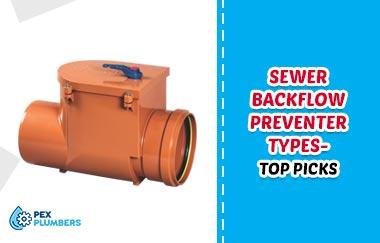
Sewer backflow preventer devices are commonly known as sanitary valves. The effectiveness of these valves varies depending on the specific type. Their purchase and installation costs will also vary.
There are three types of sewer backflow valves used in the sewage system.
1. Sewer Check Valve
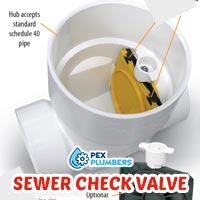
If you do a survey of valve installation in the sewage line, I suspect the name that will come the most number of times will be the sewer check valve. It incorporates a basic technique that uses the force of wastewater.
Since it’s cheaper and a practical device, it’s widely used. You should know that a sewer check valve won’t guarantee the 100% prevention of backwater.
Meaning it’ll prevent most of it so that we can tackle the first phase of sewage water backflow. According to the standards, it’s only ideal for a short-term backup which is less than a day.
When the valve flapper closes, it means you have to minimize the water use inside the homes. The flapper closing indicates backwater has started flowing back.
Once the wastewater recedes from the valves, the flapper will fall back. You can resume your normal water use.
2. Automatic Flood Gate valve
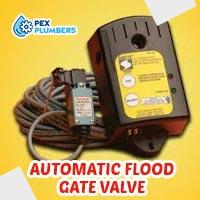
Check valves were adequate in the past. But now, with more extreme calamities such as hurricane sandy hitting us, check valves aren’t enough. And for such occasions, an automatic flood gate valve is not only perfect but necessary.
Compared to the check valve, it’s huge. It has an automated mechanism inside that requires lots of space.
The flood gate automatic valve is the most sophisticated valve used in the sewage system. If you want 100% prevention of backwater, it’s the go-to valve. It’ll ensure the protection of the building and everything inside from damage.
This automatic flood gate valve doesn’t work on electricity. It works on air pressure. The air pressure controls the automatic mechanism.
Let me explain, When wastewater flows back to the houses, the flood gate valve senses the pressure. As a result, the air pressure inside the valve builds up.
Once it reaches full potential (which is always before the water hits), a gate resembling the knife-edge shuts off the pathway preventing wastewater completely.
And since the air pressure will not decrease until and unless wastewater recedes, it means it can completely prevent backwater for a long time. That was not the case with the generic sewer check valve.
3. Manual Sewer Gate Valve
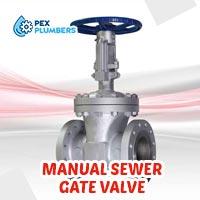
This is the simplest type of sanitary sewer valve. The name says it. It’s a manual device. Just like the manual transmission of a vehicle, it does also have to be controlled by hand.
To use this valve, one must know beforehand that a backwater occurrence is imminent. And similarly, the one handling this valve must also stay notified of the backwater condition. You have to set it back to default as soon as the backwater recedes from it.
It’s a dependable device in certain situations. But it also comes with its set of problems such as misuse of the device and backwater damage because of water force.
4. Air Gap Backflow Prevention
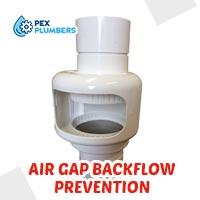
There are other ways for preventing backflow apart from valves. While this is not a device, this is a proven technique for preventing major backflow.
It’s the simplest type of backflow prevention. You can guess from the name what technique it uses. Yes, it uses an air gap to keep the wastewater away from your houses.
An air gap, in this case, is an uninterrupted space between any devices in the plumbing system. You can take the example of the water faucet on your kitchen sink and the flood level of the kitchen sink.
There’s an air gap present between them. So, in normal situations, water cannot flow back from the flood level.
This air gap eliminates any cross-connection as it acts as a barrier for backflow.
Unlike the valves, it’s totally non-mechanical, which means there’s no need for maintenance.
So there are no moving parts. It’s considered the best method of backflow prevention, but it’s not a universal solution and can be easily bypassed.
5. Other Types of Backflow Preventer
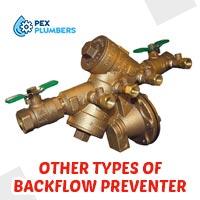
There are a few specially made backflow preventers available. These include Pressure Vacuum Breakers also known as PVB. Also among them are Reduced Principle and Residential Dual Check Valves.
Wrapping Up
So, that was all about sewer backflow preventer types. There are a few conventional and a few unconventional types of preventers, as you’ve seen. And all of them are a bit different in their mechanisms and results.
Depending on the situation and circumstance, all of them are used by the city officials. But the three main types are most commonly seen in our residential sewage water control system.
More Article For Plumbers:
- Tips for Choosing The Toilet for Rental Property
- Buying Guide to Toilet Cleaner For Hard Water Stains
- How to Connect ABS to PVC?
- Which type of PEX crimp is best?

Hey! I’m Leanda Bailey. I’m here to explain every plumbing installation and repair you may have in your kitchen or bathroom. Also, I’ll try to find you the best products on the market for your plumbing work.

